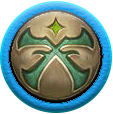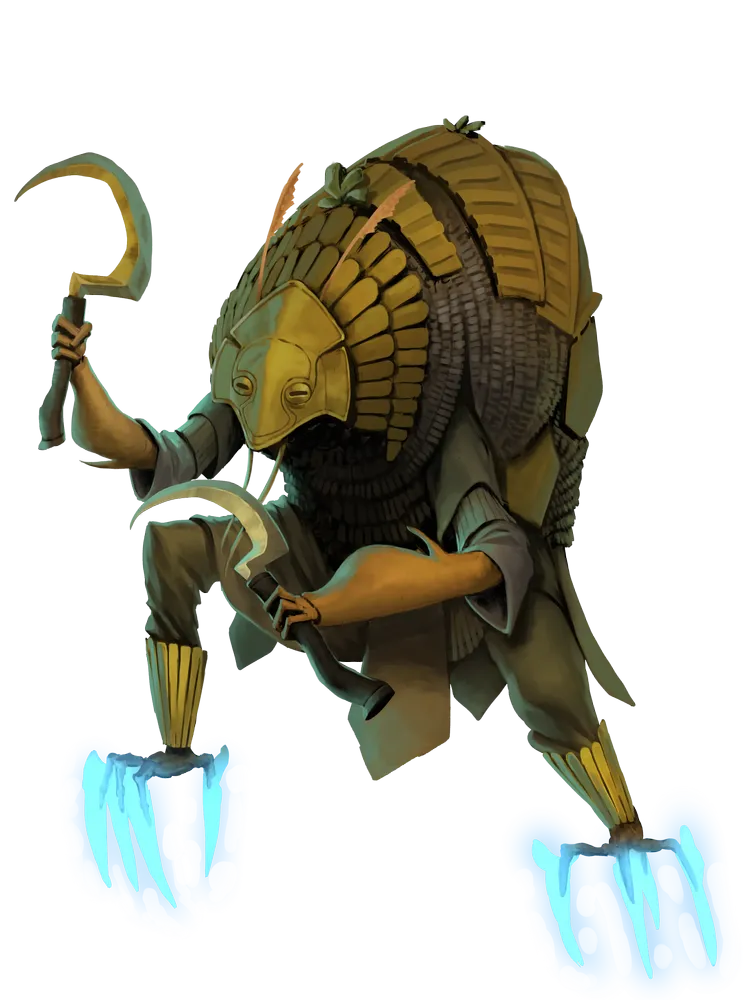
Surki
 Rare Humanoid Surki Source Howl of the Wild pg. 47 2.1Surkis are only now emerging from the subterranean Darklands in a generational dig to the surface. This insectile and highly metamorphic species subsists on the latent magic in the world around them. Once they have refined enough, surkis are capable of developing unique adaptations that allow them to project magic in diverse ways, from digging claws to energized wings.
Rare Humanoid Surki Source Howl of the Wild pg. 47 2.1Surkis are only now emerging from the subterranean Darklands in a generational dig to the surface. This insectile and highly metamorphic species subsists on the latent magic in the world around them. Once they have refined enough, surkis are capable of developing unique adaptations that allow them to project magic in diverse ways, from digging claws to energized wings.Surkis are an insectile species who subsist on the latent magic in the world around them. As a subterranean species native to the Darklands, surkis have rarely been seen on the surface, and always with long pauses between historical sightings. This is due to surkis' life cycle—long dormancies followed by so-called “generation digs,” as they migrate great distances in response to happenings underground. The healing of the Worldwound initiated one of the largest such digs in their history, bringing surkis up into the caverns and passages of the Sarkoris Scar and emerging onto the surface for the first time in many years. Since their emergence, several small surki settlements have been established in secluded corners of Sarkoris, voraciously cataloging the wildlife, magics, and various other inhabitants of the area as they explore the alien environment of the surface.
Rather than consuming food conventionally, surkis are filter feeders, absorbing magic from the air, soil, plants, stone, and practically any other material. This magic is refined and sequestered in nodes throughout a surki's body over the course of their life cycle, which is comprised of three distinct phases: larva, adult, and evolved. At each stage, surkis use their stockpiled magic to undergo a dramatic metamorphosis into their next stage of life, evolving adaptations that will help them survive in any environment. Surkis therefore vary dramatically on an individual level; each surki tells the story of their adventures and their chosen role in the environment in their unique combination of adaptations.
If you want to play a character who's exploring Golarion for the first time, with limitless adaptability and a strong tie to magic, you should play a surki.
You Might...
- Feel a very strong connection to the world around you, sensing the latent magic in everything.
- Be driven to travel far or learn as much as you can about your home.
- Pay particular attention to the way others live in environments unfamiliar to you.
Others Probably...
- Mistake your individuality and excitement for your adaptations as boastful pride.
- Find your excitement for new people, places, and things endearing and inspirational.
- Trust your magical senses over their own maps in tight situations.
Physical Description
Each of surkis' three life stages greatly differ. Larval surkis spend the first 10 to 100 years of their lives dormant inside their eggs, waiting to emerge when they've accumulated enough latent magic and the environmental conditions are just right. Larval surkis are roughly two feet long and grub-like with several luminescent nodes visible through their translucent flesh. Their heads are chitinous, round, and eyeless, and they navigate primarily using the ability to smell magic. Four of their six legs are small, but the front set are large, powerful digging claws that they use to tunnel through the earth and to communicate with the other larvae in their generation dig as they travel from their nest home. Once they've traveled far and accumulated enough magic, they enter a cocoon for several days, emerging as the adult form that's seen most often on the surface.
Adult surkis have a roughly bipedal form, standing on two multi-jointed limbs and having two arms that end in three-fingered claws used both for digging and for producing percussive sounds used in the Surki language. They possess two feathery antennae and two long sensory barbels that sit on either side of their mandibles. Surkis have a characteristic rounded shape with several rust-brown or orange chitinous plates along their back, and surki clothing and fashion tend to incorporate rounded shapes or belts around and under their plates. Their magical nodes are distributed throughout their bodies, clustering in the abdomen, shoulders, and each limb. These nodes continue to accumulate magic as they age, using it to create new adaptations, often heralded by intricate, luminescent patterns in the chitin surrounding the point of change.
The final stage in surkis' life cycle is known as the evolved form, after the surki enters its grand metamorphosis. An adult surki forms a chrysalis and rapidly changes over the course of a single evening. Less physically dramatic than the shift between larva and adulthood, the evolved form brings with it profound magical abilities that resulted from a lifetime of magical absorption and refinement. Evolved surkis' nodes metamorphose into complex organs capable of projecting tangible magic to a variety of ends, from digging apparatuses made out of pure force to glowing wings that defy gravity. This final form is the ultimate expression of any surki's individuality and adaptations—a form perfectly suited to fulfill the environment they choose to inhabit or the role they wish to fill.
Society
Surki society places great importance on individuality and self-expression. Every surki is expected to find their own way of doing things, and innovation is a highly prized achievement. Surkis are also very much in touch with their environment; they place no distinction between plant and animal, recognizing that every being fills an important part of the environment. This quality has led surkis to create settlements that leave as little impact on the environment as possible, weaving silks around plants and fungi to coax them to grow into shelters and walls. Wood and other plant-based resources are seldom harvested in a manner considered traditional to most societies in Golarion. These resources are portioned out in strategically grown sections and harvested precisely enough to not kill the plant if possible.
Surki relationships are focused on complementing adaptations. Surkis are generally polyamorous and might maintain a close bond with numerous others. Surkis are a single-sex species, and while they understand concepts of gender and orientation as experienced by other ancestries, many surkis find the idea of choosing not to bond with someone based on anatomy or personal descriptions absurd. They instead choose to pursue those with personalities, talents, or adaptations that augment their own in unexpected ways, such as using woven silks to reinforce a tunnel dug through loose rock. Nevertheless, attraction in surki society is as complicated an idea as in any other, and bonded surkis will often express their feelings toward a loved one with a personal description that expresses something they value within the relationship. For example, a surki might introduce a partner as “Who Speaks Quietly and Makes My Soil Richer.”
Only adult surkis are capable of reproducing, which they do through parthenogenesis. Any adult surki can lay an egg when they choose, though because the process expends so much of the magic stored in their nodes, few surkis lay more than one egg every few years. Many of these eggs are kept in a protected area of the settlement, awaiting the next generation dig. When the eggs are ready, they hatch en masse, and the larva coordinate their departure, drawn to magic like a beacon tunneling through the earth and stone to find a new place to settle.
Familial life vastly differs for surkis. Eggs lain outside of a generation dig are cared for and tended by the surki “parent” until the grub emerges. New village grubs are typically left to their own devices, allowed to venture outside the village or even leave the community altogether. Often, village grubs find their first homes in the soil of the community farms, where they feed on the natural magic within the soil and plant life. These gardens double as schools for these grubs, as the adult and evolved surkis who tend the gardens regularly converse with the grubs, thumping and scraping out the stories of their young lives and the lessons they've learned from others. Surki grubs born early or those whose nodes don't function well are often bonded with ostillis, small amorphous symbiotes that augment the grubs' ability to absorb nutrients from magic.
Beliefs
Surkis' connection to their environment leads them to typically worship natural deities. Their own ancient traditions identify each creature as possessing a unique spirit, with keystone species occupying a deific role within their ecosystem. Surki traditions dictate that surkis and other cultures aren't part of this spirit cycle, though with time, care, and practice, one can be accepted into it with the blessing of the environment's keystone species.
Among surki communities in Sarkoris, worship of
Gozreh and
Sturovenen has grown quickly. Surkis who dedicate themselves to a deity are more likely to choose one representing their own environment or the natural world as a whole. Deities whose domains include
travel or
change are also popular among surki devotees.
It's very important to surkis that life be allowed to follow its natural course. Death, violence, and war all have their place and purpose.
Popular Edicts encourage others to discover their true selves, protect and nurture natural ecosystems, work with others to promote symbiotic relationships
Popular Anathema force another to change before they're ready
Adventurers
Surkis are born explorers. Their innate curiosity for the world and interest in all things new, strange, and magical compel many to venture into the wild corners of Golarion. Their connection to their environment leads many to become
druids and
rangers, while their adaptability and knack for survival can make them imposing
champions. Surkis who leave their colonies often sign on as sailors or caravan guards, though it's rare to find any surki filling a position outside of their own colony
Names
Surkis choose their names when they enter adolescence. Every surki has a name referred to as their “root” or “grub” name that's produced solely with the forelimbs. Adults commonly incorporate all or part of their root name preceding their chosen name, though it isn't expected to be repeated, especially by those of other ancestries who don't possess the exoskeleton necessary to “pronounce” the name. The root name, while shown proudly, is considered the personal property of the surki who possesses it, and repetition of the root portion of a surki's name is considered rude by most, tantamount to theft. Surkis' chosen names typically represent a personal quality that they admire most or an achievement they take pride in. As surkis age, they might change their chosen name to better fit who they feel they've become. When surkis die, any present-tense verbs used in their names become past tense.
Sample Names
Bearer of Heavy Boulders, Weaver of Intricate Webs, With the Deftest Song, Who Shines Brightly, Whose Patterns are Bold, Whose Voice is Music
Surki Mechanics
Hit Points
8
Size
Medium
Speed
25 feet
Attribute Boosts
Constitution
Free
Languages
CommonSurkiAdditional languages equal to your Intelligence modifier (if positive). Choose from
Elven,
Fey,
Sakvroth, and any other languages to which you have access (such as the languages prevalent in your region).
You can see in
darkness and
dim light just as well as you can see in
bright light, though your vision in darkness is in black and white.
Magiphage
The various nodes throughout your body draw in latent magic from the world around you. You don't need to eat or drink unless you're in an especially magic-poor environment (such as the Mana Wastes). Choose what tradition of magic you most consumed as a larva; this type of magic has become so ingrained in your body that it changes the tradition of all surki spells and magical actions to that tradition.